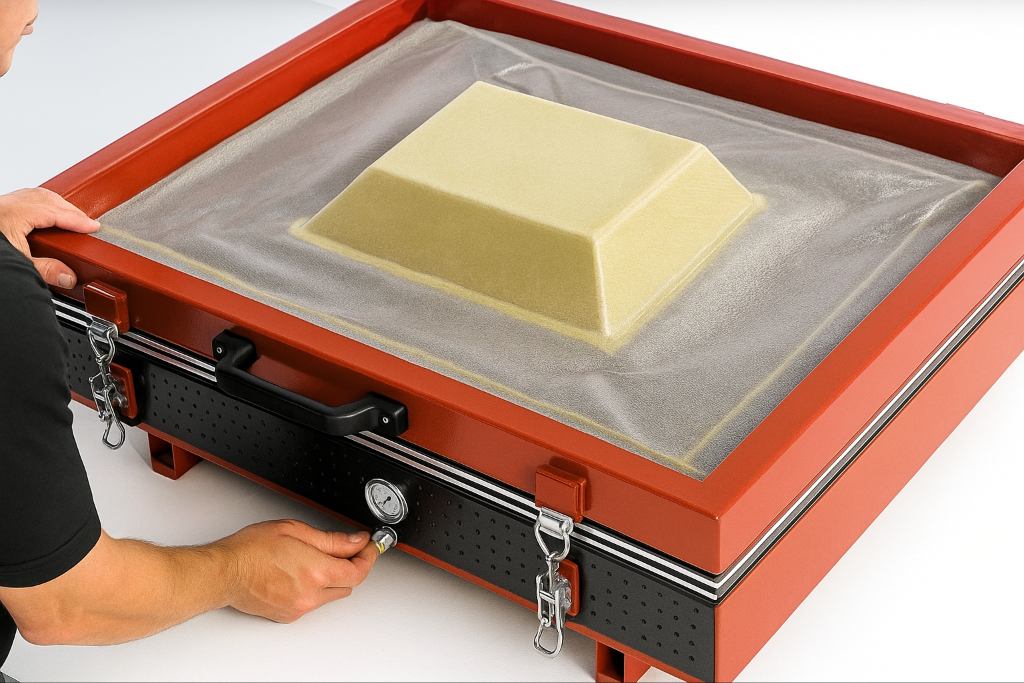What Is Vacuum Bagging in Composites and How Does It Work?
Achieving strong, lightweight, and defect-free composite parts often depends on the precision of the fabrication process. One method that has proven effectiveness is vacuum bagging composites, which involves applying uniform pressure to laminate layers to enhance consolidation and minimize voids, leading to stronger and more reliable components. This technique is widely used across industries to improve the quality and performance of composite materials.
What Is Vacuum Bagging in Composites?
Vacuum bagging composites refers to a closed molding process where layers of composite materials, such as carbon fiber or fiberglass, are laid onto a mold, then sealed in an airtight vacuum bag. Once sealed, a vacuum pump removes air from the bag, compressing the composite stack and allowing atmospheric pressure to compact the layers together.
This method allows the resin to flow evenly through the fibers, minimizing air bubbles and dry spots. With the air removed, the laminate consolidates under pressure, which boosts the fiber-to-resin ratio. That results in stronger parts without unnecessary weight. Because the process tightly compacts each layer, enhancing the strength-to-weight ratio, which is especially valuable in industries where performance and material efficiency go hand-in-hand.
The controlled environment also leads to consistent results. Voids are reduced significantly, improving aesthetics and structural integrity. Vacuum bagging composites are commonly used in aerospace, automotive, marine, and performance equipment manufacturing, anywhere lightweight yet strong parts are needed.
How the Vacuum Bagging Composites Process Works
The vacuum bagging process involves several key steps to ensure a high-quality composite part. Each step plays a role in achieving the desired structural integrity and surface finish.
1. Lay-Up Preparation
Begin by arranging layers of reinforcement fibers, such as carbon fiber or fiberglass, on a mold. The orientation and sequence of these layers are critical for achieving the required strength and stiffness in the final part.
2. Application of Release Film and Peel Ply
Place a release film over the layup to prevent adhesion between the composite and the bagging materials. A peel ply is added on top to facilitate easy removal after curing and to provide a textured surface suitable for secondary bonding.
3. Placement of Breather Cloth
Add a breather cloth over the peel ply to allow even air evacuation and resin distribution during the vacuum process. This layer helps prevent voids and ensures uniform compaction of the composite.
4. Sealing with Vacuum Bag
Enclose the entire assembly within a vacuum bag, ensuring it covers all areas of the layup. Seal the edges with sealant tape to create an airtight environment, which is essential for effective vacuum application.
5. Vacuum Application
Connect the vacuum bag to a vacuum pump and evacuate the air from the bag. The resulting vacuum pressure compresses the composite layers, removes trapped air, and facilitates proper resin flow, leading to a denser and more uniform part.
6. Curing
Allow the composite to cure under vacuum pressure, either at room temperature or in an oven, depending on the resin system used. Proper curing solidifies the composite structure and locks in the enhanced mechanical properties achieved through vacuum bagging.

Key Materials and Equipment for Vacuum Bagging Composites
Successful vacuum bagging relies on the use of specific materials and equipment designed to create and maintain the necessary vacuum environment. The primary materials required for this process are:
- Vacuum Bagging Film: This is a flexible, airtight plastic film that covers the composite lay-up and holds the vacuum. It must resist the heat and pressure of the curing process without tearing.
- Sealant Tape: A sticky, pliable tape that forms the airtight seal around the edges of the vacuum bag. It must adhere to different surfaces and maintain its seal throughout the curing cycle.
- Peel Ply: A woven fabric placed directly over the composite lay-up. It allows for clean removal after curing and leaves behind a textured surface for bonding or painting.
- Breather Fabric: This nonwoven material sits between the vacuum bag and peel ply. It helps air and excess resin flow evenly and prevents the bag from sealing off areas prematurely.
- Vacuum Pump: The heart of the system. It removes the air from the sealed vacuum bag, creating negative pressure that consolidates the composite lay-up and compacts it during curing.
Using the right materials ensures the strength of the finished product and process reliability and repeatability.
Benefits of Vacuum Bagging Composites
Implementing vacuum bagging composites offers several advantages that enhance the quality and performance of composite parts.
- Enhanced Strength and Consistency: Air pockets are eliminated with uniform pressure across the laminate. This results in stronger, smoother, and more consistent parts.
- Improved Fiber-to-Resin Ratio: Excess resin can weaken a part and add weight. Vacuum bagging removes the surplus, giving better load-bearing performance without compromising durability.
- Reduced Material Waste: Controlling the flow of resin and using efficient layering allows manufacturers to cut down on wasted material, which lowers production costs.
- Versatility: The method works with hand lay-up, resin infusion, and prepreg processes, making it adaptable to many types of production environments.
- Scalability: Whether making one-off prototypes or producing high volumes, the process scales to meet different manufacturing needs with consistent quality.
Achieve Cleaner, Stronger Parts with Smartech Vacuum Sheets
Smartech’s Reusable Vacuum Bagging Sheets are engineered for demanding composite manufacturing environments where consistency, durability, and cycle efficiency matter. Built to deliver uniform pressure and excellent resin control, our silicone and rubber membranes help eliminate voids, reduce surface defects, and improve fiber-to-resin ratios—all while maintaining repeatable performance across production runs.
Whether you’re producing high-strength aerospace components, marine laminates, or precision automotive parts, Smartech membranes offer the flexibility, heat resistance, and reusability needed to support tight tolerances and aggressive cycle demands.
Explore our full range of Silicone & Rubber Membranes designed to integrate seamlessly with your existing process. Contact our team to discuss application-specific recommendations that can improve part quality and production efficiency.
Looking for More Information?
Check out our Resources or Contact Us
